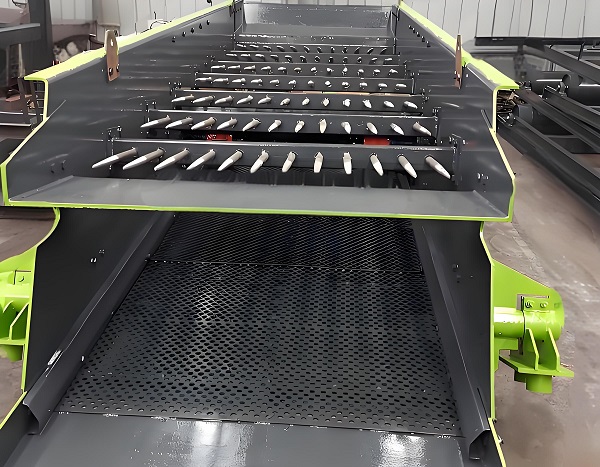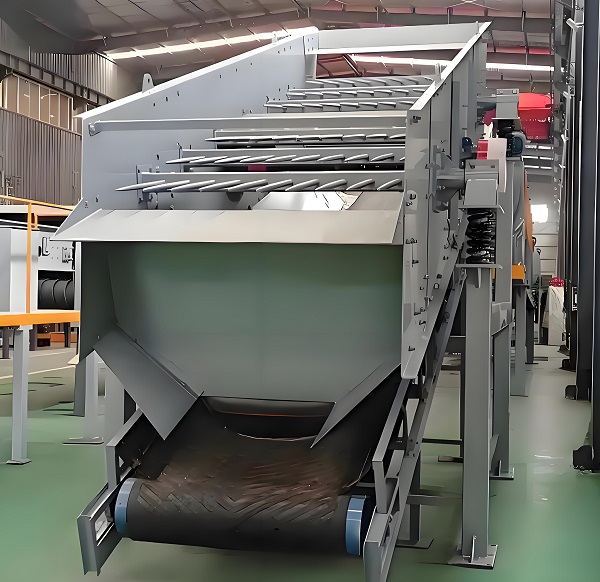In the domestic waste treatment industry chain, screening is a core prerequisite for achieving "sorting, processing, and resource recovery." Finger Screens, as specialized screening equipment designed specifically for the characteristics of domestic waste, play an irreplaceable role in waste pretreatment, impurity separation, and resource sorting, thanks to their unique structure and operating mode. They provide critical support for subsequent treatment processes such as incineration, landfilling, and resource utilization.
Finger Screen Equipment Characteristics: Structural Design Adapted to Domestic Waste

To understand the role of Finger Screens in domestic waste screening, it's first important to understand their core design, which adapts to the characteristics of domestic waste. Unlike traditional woven screens or perforated screens, Finger Screens consist of multiple parallel "bars" (typically metal rods with circular, rectangular, or trapezoidal cross-sections, often made of wear-resistant steel or stainless steel). The gap between the bars can be adjusted to meet processing requirements (typically 20-100mm). The bars also feature a smooth surface, high strength, and strong resistance to clogging. This structure allows it to easily handle the complex composition, high levels of impurities, entanglement, and large fluctuations in moisture content of household waste. The wide bar gaps prevent flexible materials like plastic bags and fabric from becoming entangled and clogging the screen surface. Furthermore, the rigid bars can withstand the impact of large pieces of material (such as bricks and scrap furniture) without deformation or damage. The smooth surface reduces the adhesion of sticky materials (such as kitchen waste), ensuring stable screening efficiency.
The Core Role of Finger Screens in Municipal Waste Screening

In municipal waste processing lines, Finger Screens are typically installed at the very front end of the process (immediately after the waste receiving bin), performing the core functions of coarse screening and pre-separation. Their specific functions can be categorized into four key areas:
1.Pretreatment: Removing Large Impurities to Protect Subsequent Equipment
Municipal waste is often mixed with large, non-combustible impurities, such as bricks and stones, concrete blocks, scrap metal components, large plastic containers (such as oil drums), and broken furniture fragments. If these impurities enter subsequent equipment such as crushers, sorters, and incinerators, they can cause serious problems. At the very least, these can cause wear and tear on crusher blades, resulting in machine jams and downtime. At worst, they can cause grate jamming and heating surface wear in incinerators, leading to equipment failure and potential safety incidents. The Finger Screen efficiently separates these large impurities through a preset gap (typically set at 50-80mm). When household waste passes through the conveyor belt and enters the Finger Screen, the vibration of the screen body forces waste particles smaller than the gap between the bars (such as kitchen waste, paper scraps, and small plastics) to fall through the gaps and enter the subsequent processing process. Large impurities larger than the gap are intercepted by the screen surface and discharged through a dedicated outlet. After manual or magnetic separation, they are sent to a landfill for disposal or resource recovery (such as metal recycling). This process eliminates potential safety hazards that threaten subsequent equipment at the source, significantly reducing equipment failure rates, extending equipment life, and ensuring continuous and stable operation of the processing line.
2. Resource Recovery: Providing "Pre-screening" for Recyclable Material Sorting
In the household waste resource utilization system, "screening first, then sorting" is the key to improving recycling efficiency. The coarse screening effect of the Finger Screen lays the foundation for the precise sorting of recyclable materials (such as paper, plastic, and metal) later. On the one hand, the grizzly screen can separate large recyclables—such as large plastic boxes, used cardboard boxes, and metal cans. These materials, due to their large size and easy identification, are intercepted by the grizzly screen and can be quickly sorted and recycled manually, preventing them from mixing with finer waste and becoming difficult to separate. On the other hand, the grizzly screen separates waste into two categories: "coarse material" (overscreen) and "fine material" (underscreen), enabling subsequent sorting equipment to operate more effectively. For example, the underscreen fine material, which contains a high proportion of food waste, can be prioritized for food waste sorting. On the other hand, the overscreen coarse material, which contains a higher proportion of plastics and textiles, can be fed into specialized plastics sorting machines (such as air separators and magnetic separators), improving the purity and recovery rate of recyclables. For example, at a municipal waste treatment plant, the introduction of the grizzly screen increased the recovery rate of plastic recyclables from 35% to 52%, significantly improving resource recovery efficiency.
3. Adaptability to Operating Conditions: Adjusting Waste Particle Size to Meet the Needs of Subsequent Treatment Processes

Different municipal waste final treatment processes (such as incineration, composting, and RDF preparation) have strict requirements for feed particle size. The Finger Screen, by adjusting the bar gap, allows for precise control of waste particle size, ensuring efficient operation of subsequent processes.
Adaptability to Incineration Processes: Incinerators require feed particles of uniform size (typically no larger than 300mm) and free of large impurities. The presence of large impurities in the waste can lead to incomplete incineration, fluctuating furnace temperatures, and increased risk of dioxin formation. The Finger Screen, with a gap setting of 50-60mm, controls waste particle size within an appropriate range while removing large impurities, resulting in "homogeneous" waste entering the incinerator, improving incineration efficiency and reducing pollutant emissions.
Adaptability to Composting Processes: Food waste composting requires a moderate particle size (typically 20-50mm). Excessively large particles will prolong the composting cycle, while too small particles can lead to poor aeration in the pile. The grizzly screen can separate large impurities (such as bricks and plastics) while allowing food waste that meets the required particle size to enter the composting system, preventing impurities from affecting compost quality and shortening the composting cycle.
Adaptable to the RDF preparation process: As mentioned above, the RDF pelletizer requires a raw material particle size of ≤50mm. The grizzly screen can serve as a "coarse screening device" for RDF raw material pre-processing, first separating large lumps (such as branches and plastic pieces) with a particle size exceeding 50mm. The undersized material is then fed into the crusher for further crushing, ensuring that the final raw material entering the pelletizer meets the required particle size and improving the quality of the RDF pellets.
4. Volume Reduction: Reduces Subsequent Processing Load and Disposal Costs
One of the core goals of municipal waste treatment is volume reduction. By separating large, non-combustible impurities, Finger Screens can directly reduce the burden and costs of subsequent processing.
Large, non-combustible impurities (such as bricks, stones, and concrete) typically account for 5%-15% of municipal waste. If these impurities are not separated in advance, they will enter the incinerator or landfill along with the waste. Impurities in incinerators cannot be burned and are ultimately discharged as slag, increasing the slag handling capacity. Impurities in landfills occupy storage capacity, shortening the landfill's lifespan. By pre-separating these impurities, the Finger Screen can reduce the "effective processing volume" required for subsequent incineration or landfill by 5%-15%, directly reducing incineration energy consumption (no fuel is consumed for non-combustible impurities) and landfill costs (reduced storage capacity).

In terms of quality, the waste separated by the Finger Screen is more "pure"—for example, removing large pieces of plastic reduces harmful gases produced during incineration; removing bricks and stones prevents contamination of the compost product by impurities during the composting process. This "quality improvement" indirectly reduces the environmental costs of subsequent processing and reduces investment in pollutant control.
Although the Finger Screen is considered a "coarse screening device" in the domestic waste treatment line, its role spans multiple core links, including pretreatment, resource recovery, process adaptation, and waste reduction. It serves as a "safety barrier" to protect subsequent equipment, a "pre-processing aid" to improve resource recovery efficiency, and a "regulating valve" to adapt to different treatment processes. Against the backdrop of the increasingly urgent need to treat domestic waste in a harmless, reduced, and resource-efficient manner, the rational application of Finger Screens can significantly improve the operational efficiency and environmental benefits of the entire waste treatment line, providing key technical support for building a sustainable waste treatment system. Whether in large-scale waste incineration plants, composting plants, or RDF production bases, Finger Screens have become an indispensable core pretreatment equipment. Their full utilization directly determines the stability and economic efficiency of subsequent treatment processes.
Save Time! Get A Detailed Quotation Quickly.
